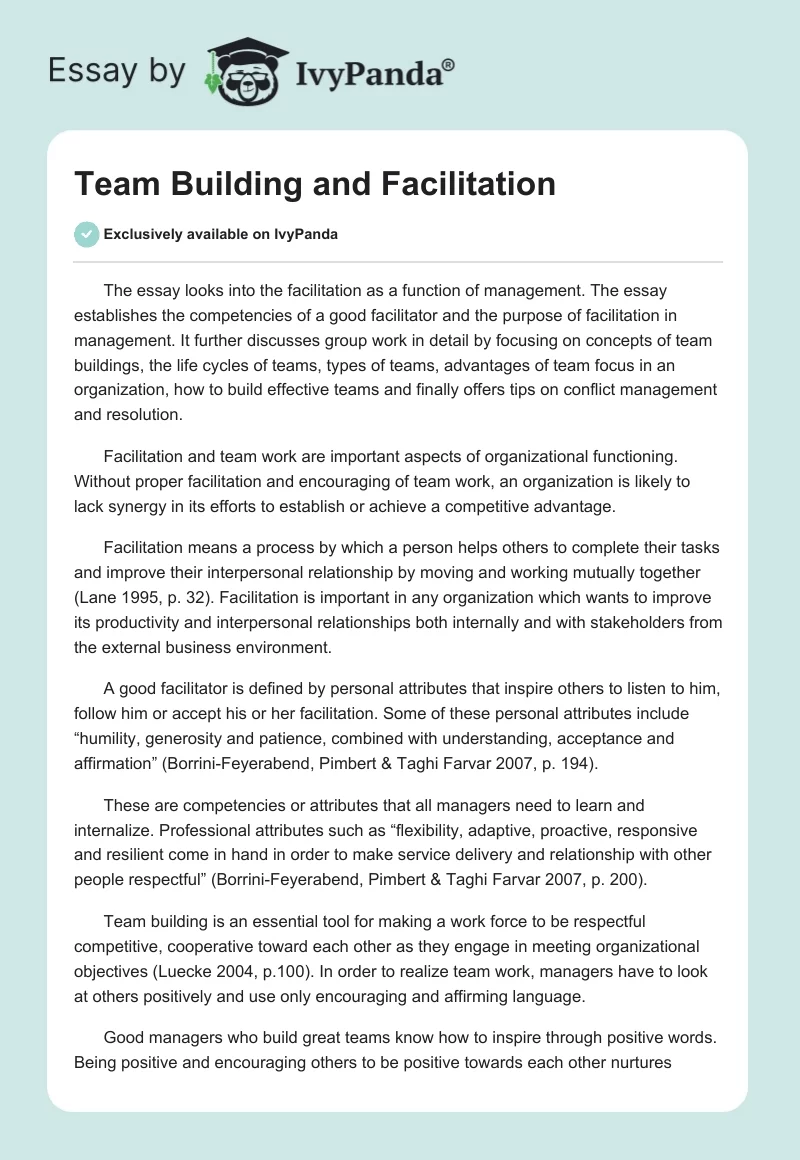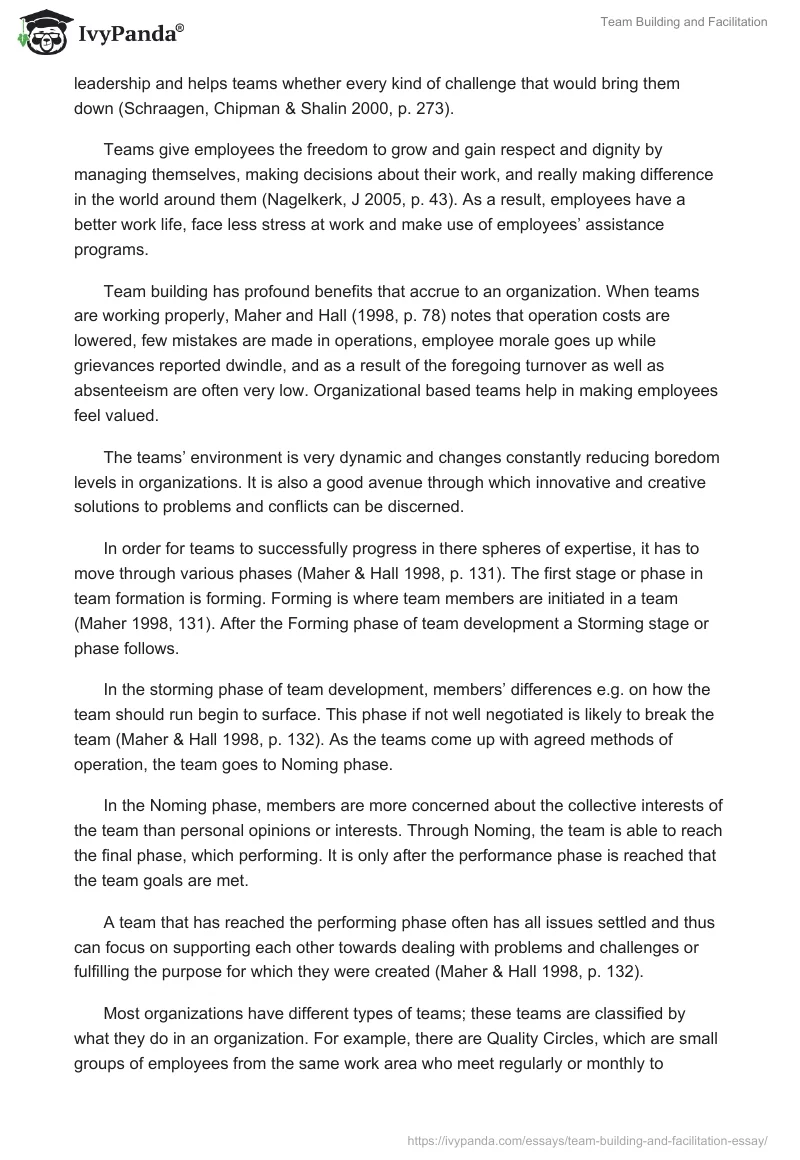The essay looks into the facilitation as a function of management. The essay establishes the competencies of a good facilitator and the purpose of facilitation in management. It further discusses group work in detail by focusing on concepts of team buildings, the life cycles of teams, types of teams, advantages of team focus in an organization, how to build effective teams and finally offers tips on conflict management and resolution.
Facilitation and team work are important aspects of organizational functioning. Without proper facilitation and encouraging of team work, an organization is likely to lack synergy in its efforts to establish or achieve a competitive advantage.
Facilitation means a process by which a person helps others to complete their tasks and improve their interpersonal relationship by moving and working mutually together (Lane 1995, p. 32). Facilitation is important in any organization which wants to improve its productivity and interpersonal relationships both internally and with stakeholders from the external business environment.
A good facilitator is defined by personal attributes that inspire others to listen to him, follow him or accept his or her facilitation. Some of these personal attributes include “humility, generosity and patience, combined with understanding, acceptance and affirmation” (Borrini-Feyerabend, Pimbert & Taghi Farvar 2007, p. 194).
These are competencies or attributes that all managers need to learn and internalize. Professional attributes such as “flexibility, adaptive, proactive, responsive and resilient come in hand in order to make service delivery and relationship with other people respectful” (Borrini-Feyerabend, Pimbert & Taghi Farvar 2007, p. 200).
Team building is an essential tool for making a work force to be respectful competitive, cooperative toward each other as they engage in meeting organizational objectives (Luecke 2004, p.100). In order to realize team work, managers have to look at others positively and use only encouraging and affirming language.
Good managers who build great teams know how to inspire through positive words. Being positive and encouraging others to be positive towards each other nurtures leadership and helps teams whether every kind of challenge that would bring them down (Schraagen, Chipman & Shalin 2000, p. 273).
Teams give employees the freedom to grow and gain respect and dignity by managing themselves, making decisions about their work, and really making difference in the world around them (Nagelkerk, J 2005, p. 43). As a result, employees have a better work life, face less stress at work and make use of employees’ assistance programs.
Team building has profound benefits that accrue to an organization. When teams are working properly, Maher and Hall (1998, p. 78) notes that operation costs are lowered, few mistakes are made in operations, employee morale goes up while grievances reported dwindle, and as a result of the foregoing turnover as well as absenteeism are often very low. Organizational based teams help in making employees feel valued.
The teams’ environment is very dynamic and changes constantly reducing boredom levels in organizations. It is also a good avenue through which innovative and creative solutions to problems and conflicts can be discerned.
In order for teams to successfully progress in there spheres of expertise, it has to move through various phases (Maher & Hall 1998, p. 131). The first stage or phase in team formation is forming. Forming is where team members are initiated in a team (Maher 1998, 131). After the Forming phase of team development a Storming stage or phase follows.
In the storming phase of team development, members’ differences e.g. on how the team should run begin to surface. This phase if not well negotiated is likely to break the team (Maher & Hall 1998, p. 132). As the teams come up with agreed methods of operation, the team goes to Noming phase.
In the Noming phase, members are more concerned about the collective interests of the team than personal opinions or interests. Through Noming, the team is able to reach the final phase, which performing. It is only after the performance phase is reached that the team goals are met.
A team that has reached the performing phase often has all issues settled and thus can focus on supporting each other towards dealing with problems and challenges or fulfilling the purpose for which they were created (Maher & Hall 1998, p. 132).
Most organizations have different types of teams; these teams are classified by what they do in an organization. For example, there are Quality Circles, which are small groups of employees from the same work area who meet regularly or monthly to discuss and recommend solutions to workplace problems (Griffin & Moorhead 2009, p. 260).
We have Work teams, which are often permanent teams or units that engage in daily work in the organization. There are also problem solving teams that are temporary in nature and are often set up to deal with a specific problem in the workplace (Griffin & Moorhead 2009, p. 261).
Other types of teams are called management teams, which often consists of different managers and help in coordinating different tasks in the organization (Griffin& Moorhead 2009, p. 261). Management teams are relatively permanent because their work does not end with a particular project or resolution of a problem.
Team work is important for any given organization for its productivity and growth; its merits outweighs its demerits for instance people who have greater talents are tapped by an organization, and the teams management environment offers an opportunity for people to make better use of their talents (Baldwin & Migneault 1996, p. 15).
Individual working in a team contribute ideas, which are coalesced into one strong offering or one solution to a problem; a process that helps individuals learn problem solving skills, unlike working on the problem alone (Baldwin& Migneault 1996, p.16).
However, Its demerits is that team members may ignore their own work when paying attention to team activity, hence they may not have self discipline or required skills for teamwork (Baldwin& Migneault 1996, p. 15). Empowered employees may not know their limits. Teams are inefficient because they demand continuing attention from management authority to their development and operation (Baldwin& Migneault 1996, p. 16).
They don’t own a clear communication or decision making policy, and hence they are sometimes inclined towards group think (Baldwin& Migneault 1996, p. 16). Top management authorities do not wish to share their authority with others, moreover, they do not have unity of purpose and unwilling to cooperate in an elitist and academic environment (Baldwin& Migneault 1996, p. 18).
In order to build an effective team, clear expectations have to be considered for the optimum team performance. It is critical to outline clearly what the teams wants to achieve and why the expectations were created (Haskins, Mellor & Macrae 1987, p. 123). Context of the team has to be spelled out, this is essential because it will be possible to see the image of an organization’s goals and values.
Commitment is also critical; the members should be willing to devote to accomplishing the teams expected mission and come out with clear output. They should be prepared to accept the challenge that comes with this. Competent, innovative people who have the right skills, knowledge, and creative thinkers and the capability to address the issues of which was spelled out in the teams being set up is important.
Communication is important in a team realizing its goals; the company should give important business information to teams and in return, a feedback should be given back for analysis, they should understand the context of their existence (Vineyard& Lynch 1991, p. 148). The team should have control where boundaries are set and know their limitations.
Effective management of an organization is dependent on effective communication, conflict resolution, and the creation of an inclusive organizational culture to succeed (Butterfoss 2007, p. 143). Work related conflicts are caused by several factors; opposing conflicts when passing a point across communicate clearly and explain this reduces the concept of misunderstanding (Butterfoss 2007, p. 143).
Roused emotions sometimes bring discussion more neutral, impersonal level and explore the problem more calmly (Butterfoss 2007, p. 144). Team culture, having negative team culture can make negotiation extremely difficult; both discussions should be approached with a positive mind.
Conflict at work place can have adverse effects to the parties involved, teams and to the business as a whole, but these conflicts can be prevented early in advance before they occur (Guffey, Rogin & Rhodhes 2008, p. 69).
To effectively solve and get rid of this work related conflicts sound strategies have to be employed to create and environment which is free and comfortable for work (Bacal 1998, p. 10). Communication is critical towards avoiding conflicts. It is advised that in interpersonal interactions, individuals own their own feelings and messages thus taking responsibility for import of their words (Bacal 1998, p. 110).
Apart from speaking respectively through owning personal feelings and messages employs have to learn listening skills. Listening skills help employs listen and really understand whatsoever is said to them. It is not just about hearing what the other is saying but also helping the other towards making himself or herself understood (Guffey, Rogin & Rhodhes 2008, p. 79).
In employee related conflict management, use of behavioral consequences for uncooperative employees who are unwilling to change is inevitable (Falconer 2004, p. 54). Some employees feel afraid or despise change and it takes them ages to change anything because of their unwillingness. Managers have to be able to clearly communicate what consequences would accrue to employees who are unwilling to change their problematic behaviors (Bacal 1998, p. 12).
In conclusion, for effective team building and efficient management in organizations, managers have to realize the need of concrete facilitation skills. Facilitation skills are critical toward the creation of a nurturing environment for work.
References
Bacal, R 1998. Conflict Prevention in the Workplace Using Cooperative Communication, Bacal & Associates, New York
Baldwin, David, A & Migneault, RL 1996, Humanistic Management by Teamwork: An Organizational and Administrative Alternative for Academic Libraries, Libraries Unlimited, New Orleans.
Borrini-Feyerabend, G, Pimbert, M & Taghi Farvar, M 2007, Learning-By-Doing in Co- Management of Natural Resources throughout the World, Earthscan, New York
Butterfoss, Dunn, F 2007, Coalitions and Partnerships in Community Health, John Wiley and Sons: New York
Falconer, H 2004, IRS Managing Conflict in the Workplace, Butterworth-Heinemann, London
Griffin, Ricky, W, & Moorhead, G 2009. Managing People and Organizations Cengage Learning, New York
Guffey, Mary, E, Rogin, P & Rhodhes, K 2008, Business Communication: Process and Product, Cengage Learning, New York.
Haskins, G, Williams, R, Mellor, J, Macrae, N 1987. Intrapreneurship: Successful European Company Practices, Economist Publications Ltd, London.
Lane, Pamela, S 1995, Conflict Resolution for Kids: A Group Facilitator’s Guide, Taylor & Francis, New York
Luecke, Richard, 2004. Managers Toolkit: The 13 Skills Managers Need to Succeed Harvard Business Press, Harvard.
Maher, H and Hall, P 1998, The Manager’s Guide To Planning And Leading Change Projects, Cengage Learning EMEA, New York
Nagelkerk, J 2005. Study Guide for Huber: Leadership and Nursing Care Management, Saunders, California.
Schraagen, J, M, Chipman, S, F, & Shalin, V 2000, Cognitive Task Analysis, Routledge, New York
Vineyard, S & Lynch, R 1991, Secrets of Leadership Heritage Arts Economist Publications Ltd, London


